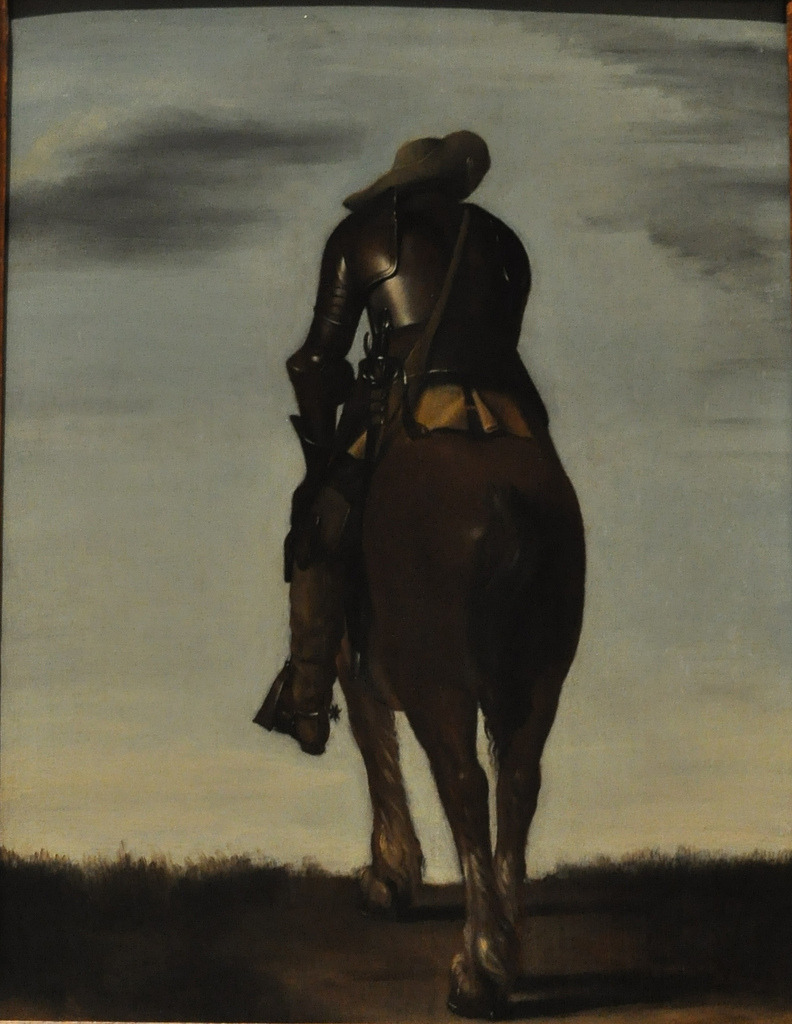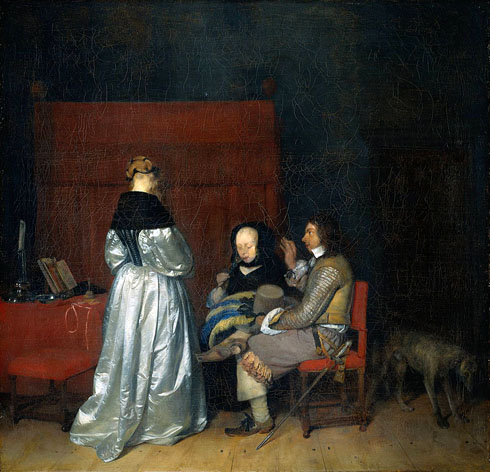Friday, December 14, 2012
Gerard ter Borch
Gerard ter Borch II The Suitor's Visit, c. 1658 oil on canvas, 80 x 75 cm (31 1/2 x 29 9/16); framed: 110.8 x 106 x 12.7 cm (43 5/8 x 41 3/4 x 5) National Gallery of Art, Washington, Andrew W. Mellon Collection
Gerard ter Borch, one of the finest of all Dutch 17th-century painters, was shown in his full splendor in this magnificent exhibition, the first ever devoted to his work in the United States. Gerard ter Borch presented over 50 of the artist's exquisite portraits and genre scenes from public and private collections in the United States and Europe. On view at the National Gallery of Art, West Building, from November 7, 2004, through January 30, 2005, Gerard ter Borch then traveled to the Detroit Institute of Arts, where it will be on view from February 27 through May 22, 2005. A small selection of paintings from the exhibition were shown at the Rijksmuseum, Amsterdam, from June 9 through September 4, 2005.
The paintings of Gerard ter Borch (1617-1681) are remarkably varied, and the selection in this exhibition represented each aspect of his career, from his striking early picture
of a lonely soldier on horseback from the 1630s, to his masterful depiction of the delegates signing the Treaty of Münster in 1648, to his mid-career representations of women engaged in domestic activities, and to the refined portraits of Dutch burghers that brought him prosperity throughout his professional life.
The exhibition was organized by the American Federation of the Arts, New York, and the National Gallery of Art, Washington.
Exhibition Support
The exhibition is supported by an indemnity from the Federal Council on the Arts and the Humanities.
The Exhibition
Ter Borch is best known today for his refined genre scenes, which typically depict two or three elegantly clad figures engaged in an activity such as letter writing or music making. No other Dutch artist has ever captured so well the subtle psychological interactions between figures. Neither has any artist conveyed as effectively as he the shimmering surface of satin nor the undulating rhythms of a translucent lace cuff. Ter Borch captured with exceptional sensitivity the complex inner life of his subjects through tiny gestures, covert glances, and carefully observed expressions. Among the major paintings in the exhibition that represent this facet of his oeuvre are
A Young Woman at Her Toilet with a Maid (c.1650/1651),
Gallant Conversation--better known as Paternal Admonition (c.1654)
and The Suitor's Visit (c. 1658) (Above).
Though his "high-life" scenes are more familiar, Ter Borch also showed extraordinary skill in painting more humble subjects, and the exhibition presents several examples, including
The Grinder's Family (c.1653),
A Maid Milking a Cow in a Barn (c.1653/1654)
and A Horse Stable (c.1654).
Ter Borch was also a remarkable portrait painter. The confident postures and solemn expressions of the burghers in his small-scale, full-length portraits reflect their dignity and affluence. Executed with great sensitivity of touch, these portraits are distinctive for their psychological intensity. One particularly delightful example is his portrait of the young Helena van der Schalcke (c.1648).
By the 1640s, Ter Borch was asked to accompany the Dutch delegates to Münster to record the signing of the treaty that would end the Eighty Years' War between Spain and the Dutch Republic. His remarkable painting,
The Swearing of the Oath of Ratification of the Treaty of Münster, 15 May 1648 (1648)
is the most important image recording this historic event. In Münster, Ter Borch also painted sensitive small-scale portraits on copper of individual delegates from the Netherlands and Spain.
Ter Borch's later full-length portraits depict sitters with reserved yet confident postures. Their solemn, noble expressions reflect the dignity and affluence of his sitters. One remarkable work in the exhibition was the large-scale group portrait,
The Town Council of Deventer (1667). Its opulent frame is decorated with symbolic elements indicating the powers and responsibilities of the magistrates.
The Artist
Ter Borch was born into a wealthy family of artists in Zwolle, a garrison town near the eastern border of the Netherlands. There the artist observed aspects of military life that would later figure in his paintings. Ter Borch received his first artistic training from his father, an amateur artist and tax collector. After serving apprenticeships in Amsterdam and Haarlem in the early 1630s, he traveled to London to study with his stepuncle, who made engravings after the refined portraits of Anthony van Dyck. In 1637, Ter Borch set off for Spain where his style was further influenced by the expressive portraiture of Diego Velásquez. Ter Borch, however, rendered his portraits on a smaller scale and in a more delicate manner, often on copper or panel.
After returning to the Netherlands, Ter Borch probably settled in Amsterdam. His reputation as a portrait painter earned him an invitation to accompany Dutch delegates to the peace congress in Münster, where he painted the ratification of the treaty that marked the foundation of the Dutch Republic. During the 1650s, Ter Borch began to paint the elegant genre scenes for which he is now most celebrated. Following his marriage to a wealthy widow in 1654, the artist moved to her hometown of Deventer and became the preferred portraitist of its leading citizens. Ter Borch soon joined the ranks of the city's ruling elite and died there at the age of 64 in 1681.
Curators, Catalogue, and Related Activities
The exhibition was curated by Arthur K. Wheelock Jr., curator of northern baroque painting at the National Gallery of Art since 1984 and curator of such major Gallery exhibitions as Johannes Vermeer (1995–1996) and Jan Steen: Painter and Storyteller (1996).
Gerard ter Borch was accompanied by the first major English-language publication on the artist, which is a significant contribution to the study of 17th-century Dutch painting. Published in English by the National Gallery of Art and the American Federation of Arts in association with Yale University Press, the 240-page exhibition catalogue includes full-color reproductions and entries for each of the paintings in the exhibition written by Wheelock, Alison McNeil Kettering, and Marjorie E. Wieseman. It also includes essays on the artistic development of Ter Borch by Wheelock and on the artist's modern style by Kettering, as well as a study of Ter Borch's techniques for painting satin by Arie Wallert, curator at the Rijksmuseum. A Dutch edition is available from Waanders Publishers, Zwolle.




_-_The_Family_of_the_Stone_Grinder_-_WGA22124.jpg)



